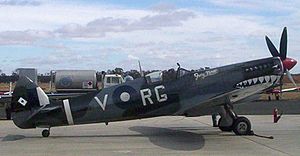| Spitfire | |
|---|---|
 A restored Supermarine Spitfire VIII, A58-758, in the colours and markings of Wg. Cdr Bobby Gibbes of 80 Wing RAAF, based on Morotai in 1945. | |
| General information | |
| Type | Fighter / Photo-reconnaissance |
| Manufacturer | Supermarine |
| Designer | |
| Primary user | Royal Air Force |
| Number built | 8,996 (20,346 total)[1] |
| History | |
| Manufactured | 1942–1945 |
| Introduction date | June 1942 (Mk IX) |
| First flight | September 1941 (Mk III with Merlin 61) |
| Retired | 1955, RAF |
| Variants | Seafire, Spiteful, Seafang |

The British Supermarine Spitfire was facing several challenges by mid-1942. The debut of the formidable Focke-Wulf Fw 190 in late 1941 had caused problems for RAF fighter squadrons flying the latest Spitfire Mk Vb.[2] Rolls-Royce engineers were already working on a new version of the Merlin incorporating a two-stage supercharger; the combination of the improved Merlin and the Spitfire Mk Vc airframe in a "stop-gap" design allowed the RAF to combat the Fw 190 on equal terms.
In a second stream of development Supermarine was working on an improved, reinforced, Spitfire airframe which incorporated several new features and was designed for the Merlin 60 and 70 series engines.[3] This new airframe later formed the basis for the Rolls-Royce Griffon powered Spitfires. This article presents a history of the Spitfire powered by two-stage engine variants and also describes some of the "drawing board" projects and experimental Spitfires. The Griffon powered variants are described in a separate article.